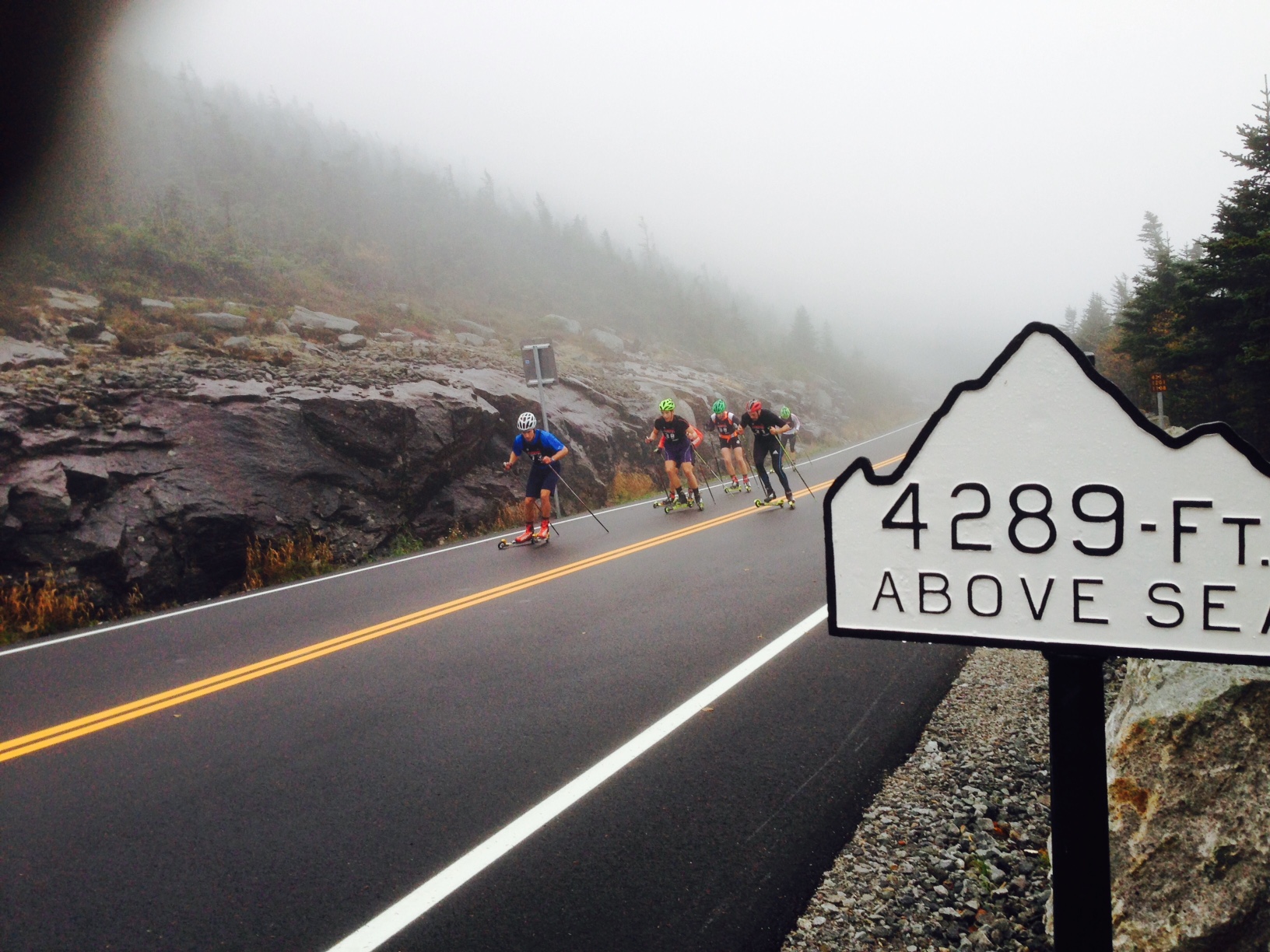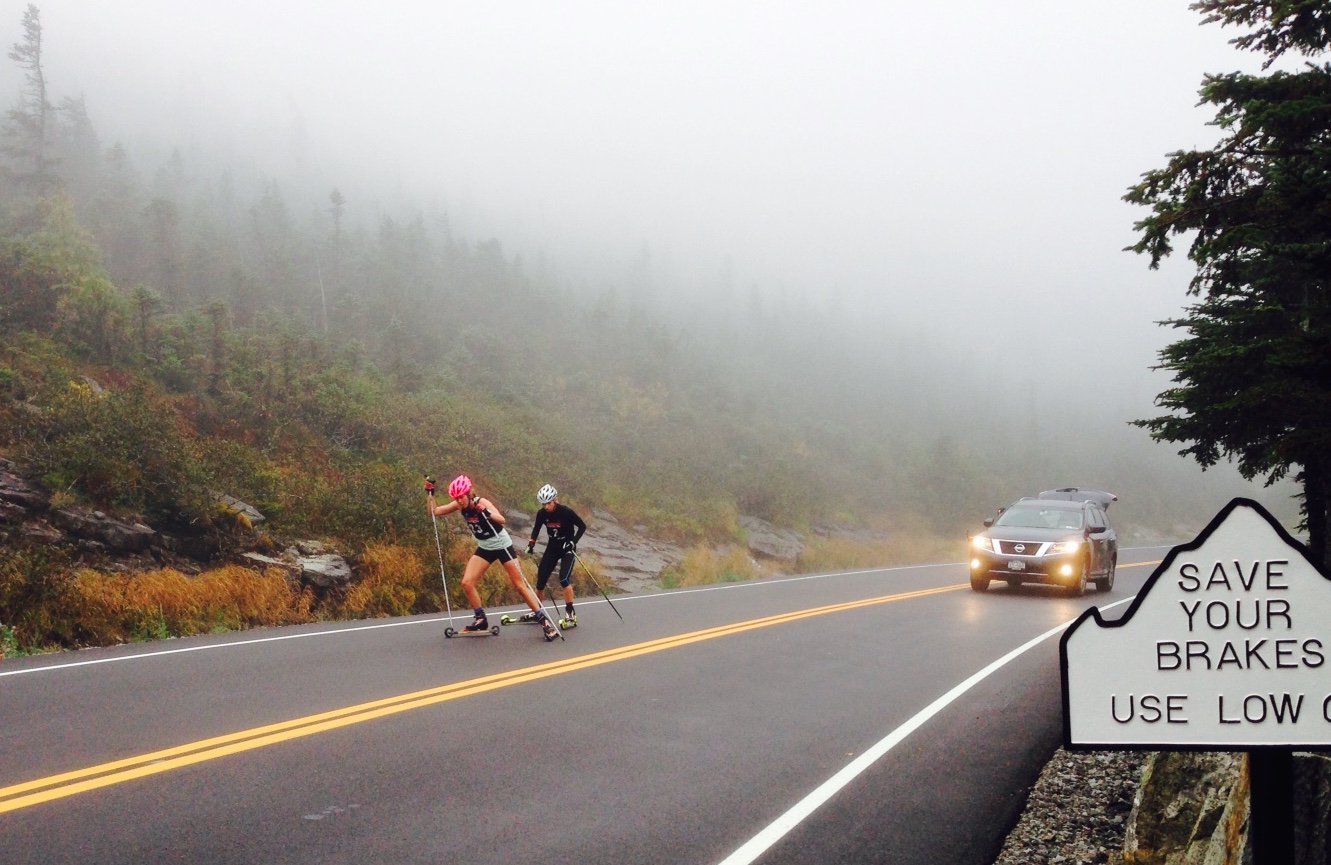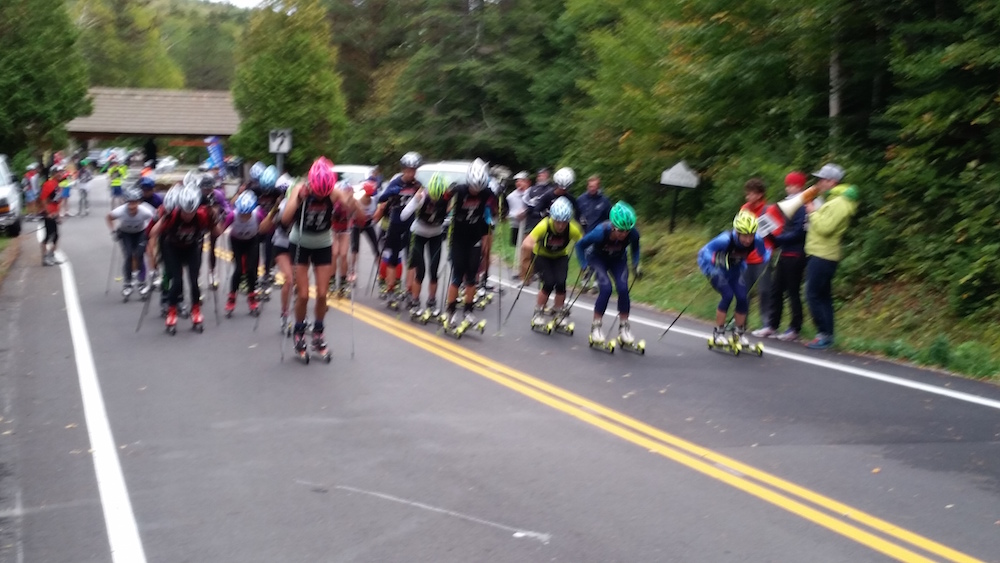
Paddy Caldwell of the U.S. Ski Crew D-group and SMST2 Team won Sunday’s Climb to the Castle up Whiteface Mountain in Wilmington, N.Y. Here, around mile 4 of 5, he’s witnessed foremost the pack, which contains biathletes Russell Currier and Tim Burke, and Rogan Brown (SVSEF) and Kyle Bratrud (CXC). (Photo: Tim Cowan)
For years, U.S. Nordic Ski Group athletes and their coaches trucked themselves up to the commence of the Whiteface Veterans Memorial Highway, clicked into their rollerskis and permitted an ample amount of time for warming up ahead of ascending New York’s fifth highest peak.
Ahead of it grew to become an official race 9 many years in the past, it was a exercise: a 5-mile grind to the summit of Whiteface Mountain, four,867 feet over sea level in Wilmington, N.Y.
Now, for a lot of prime-degree skiers, particularly these primarily based on the East Coast, the yearly Climb to the Castle an offseason staple. And if you win, you get a T-shirt and a medal for your efforts.

Mary Rose (SVSEF) prospects US Biathlon’s Annelies Cook up the Whiteface Mountain toll street during the yearly Climb to the Castle. Rose won and Cook completed second, 32 seconds later on. (Photograph: Tim Cowan)
“Climb to the Castle was a blast this 12 months!” wrote women’s winner Mary Rose of Idaho’s Sun Valley Ski Education Foundation (SVSEF) Gold Staff. “My objective going into this race was to have good power the entire time, focus on strategy and hopefully place with each other a great energy.”
She reached the prime on Sunday in 45:15.1 and topped her competition — the closest of which was US Biathlon’s Annelies Cook — by 32.6 seconds.
“It was a fun, difficult effort,” men’s winner Patrick Caldwell of the U.S. Ski Group D-group and Stratton Mountain College (SMS) T2 Team said in an interview soon after the finish.
The 21-yr-old Caldwell outlasted biathletes Russell Currier and Tim Burke by five and 11.five seconds, respectively. Caldwell won in 37:05.two, Currier was second and Burke was third.
“Right from the start off, we stayed pretty significantly collectively against a decent headwind,” Burke mentioned right after the finish. “I think a great deal of us had been fatigued at the finish of a big camp, so I did not genuinely want to push like crazy.”
The US Biathlon and U.S. Nordic teams invested at least the last week coaching in Lake Placid, N.Y., with biathletes like Burke logging five race efforts in 9 days preceding the Climb.
“I determined today instead of going for time, I desired to go for the win,” explained Burke, a defending numerous-time Climb to the Castle (C2C) champion. “So I determined to sit in and push that last half mile.”

Paddy Caldwell (U.S. Ski Group/SMST2) at left is observed major close to mile four in Sunday’s Climb to the Castle up Whiteface Mountain in Wilmington, N.Y., followed by biathlete Tim Burke (second from l) and 3 other individuals. (Photo: Tim Cowan)
He mentioned he “did a whole lot of pulling and received some support in the direction of the end.” Caldwell led about mile four, and Burke explained that 5 males battled in the lead pack for the last two miles.
“I broke my pole in the final couple hundred meters, that sort of took me out of it,” he explained.
Caldwell took the blame what he called an “unfortunate incident” in the final 200 meters. “I broke Tim Burke’s pole,” he explained. He did so when Burke manufactured his last attack toward the finish.
“Aside from that, it was a great, reliable race,” Caldwell explained.
“It’s a good way to end it,” Burke explained after ten days of difficult education.
Currier, who placed second, named it an “entertaining race” with five males contending all through.
“For a uncommon modify I was capable to be on the greater side of techniques and consistently remain in the back of the pack,” Currier wrote in an e-mail. “On the other hand, the last 100 meters came up a good deal earlier than I anticipated and didn’t give much time to react. The tempo picked up and Tim Burke misplaced a pole tip. The subsequent point I knew there was an opening for the lead. I’m not much of a sprinter and didn’t do considerably to challenge Patrick, but was I was nonetheless pleased to break out of the back of the pack just in time for the podium.”
A former US Biathlon (USBA) B-team member, Currier, who trains with the Maine Winter Sports activities Center, was not renamed to the crew this spring and is operating in direction of creating the minimize through a series of trials ending in October.
“The status for the Nationwide group is still very unclear,” he wrote. “… All I can do is make the ideal of each instruction session and go for much better benefits. The 2nd round of trials is coming up in October. A couple of great adequate outcomes there need to support my cause for the coming race season.”
Rogan Brown (SVSEF) placed fourth in the men’s race, four.three seconds from the podium and 15.eight seconds right after Caldwell. Brown edged Kyle Bratrud of Central Cross Country (CXC) by .3 seconds, and behind them, yet another CXC skier Duncan Douglas positioned sixth.
USBA’s Sean Doherty and Lowell Bailey finished seventh and eighth, respectively, Miles Havlick (SVSEF) was ninth and establishing biathlete Max Durtschi completed 10th of 61 men.

The start of the women’s race at the 2015 Climb to the Castle up Whiteface Mountain in Wilmington, N.Y. (Photograph: Peter Minde)
In the women’s race, Rose and Cook pushed every single other to the leading. Rose recalled it currently being just the two of them shortly following the start off. A perennial contender, USBA’s Susan Dunklee had some pole issues at the very starting, Rose explained in an electronic mail.
“I knew I required to break away about 1/2 mile to the finish because I can’t beat [Cook] in a sprint,” Rose wrote. “I fought rather challenging by means of the ‘wind tunnel’ and I think that is where I broke away.”
Overnight rain left the toll road moist, and wind dried out its lower sections. From about the halfway point to the finish, skiers pushed through mist on wet pavement and faced a regular wind blowing 10 to 20 miles per hour all through the race. After starting up in temperatures about 47 degrees Fahrenheit, they met temperatures in the mid-30’s at the top.
“It sounds weird to say it aloud, but I actually had exciting performing the climb to the castle,” Cook wrote in an e mail. “Mary and I skied collectively the complete time and switched prospects back and forth. I usually get bored carrying out the climb and shed concentrate and switching back and forth with her kept me in the game mentally.
“She received me at the final flip correct ahead of the finish when I out of the blue flooded with lactic acid and had no likelihood,” she added. “But I don’t genuinely consider of myself as a climber and so it was fun to be the two men and women top the race. That doesn’t come about as well typically! Of course, the usual suspects had been not there and that certainly produced it big difference.”
With the exception of Paddy Caldwell, the U.S. Ski Crew (USST) skipped the Climb this 12 months for the 1st time in years.
“As tough as it is to miss it due to the fact it is a amazing event, it just didn’t play nicely athletically for the wants of the group,” USST Head Coach Chris Grover stated on the phone last week. “We wished to do a lot more sprint-particular instruction and quick intensity as opposed to providing up a total workout or two to do the Climb to the Castle.”
The USST camp was also only a week long, compared to the two weeks the staff usually spends in Lake Placid this time of yr. On the other hand, the largely Lake-Placid-based US Biathlon team did either time trials or Degree five (race-speed) routines for final 10 days.
“I had my personalized very best by fairly a great deal and I felt strong skiing,” Cook said of the Climb. “It felt very good to end a really challenging 10 days on a excellent note. … I think we are all quite glad to be completed.”
The Climb marked the end of a two-week coaching block for Rose and her Sun Valley teammates, who had been in Stratton, Vt., with the SMST2 staff for the first week.
“We had some super hard intensity sessions above the previous two weeks and all were very productive,” Rose wrote.
USBA’s Hannah Dreissigacker, who placed third, two:05.9 right after Rose, explained in an e mail that the women’s race broke up quickly.
“Mary and Annelies started out off a small more quickly than I genuinely desired to be going, and I tried to hold on for a bit but then gave up pretty swiftly and lost contact,” Dreissigacker wrote. “My aim in the Climb to the Castle is constantly to not begin too rapidly and then blow up. Then I skied with Susan for a mile or so and then slowly inched ahead of her a bit. Eventually we skied into a cloud and I misplaced sight of Annelies and Mary and just skied the total 2nd half by myself.”
She finished 1:10.9 ahead of Dunklee, who placed fourth, although wearing a figure-skating tutu she wore the very first time she did the race.
“The lacy elbows really allowed for added breathability and the rhinestones gave me some added determination on individuals lengthy difficult stretches when I was all alone,” Dreissigacker wrote.
Another biathlete, Clare Egan finished fifth, Paige Schember (SVSEF) was sixth, Erin Perryman (St. Lawrence University) was seventh, Jackie Garso of the nearby New York Ski Training Basis (NYSEF) was eighth, St. Michael’s assistant coach Silke Hynes was ninth, and Stratton U16 skier Anna Lehmann was 10th of 25 females.
Results: Guys | Women